Introduction
As technology progresses, the importance of environmental monitoring has grown significantly. As worries about climate change, air pollution, and natural disasters increase, the weather station is now crucial.
Many industries rely on it. This device combines several environmental monitoring capabilities and is being utilized in a broad spectrum of applications. In this article, we will explore the parts of an ambient weather station. We will also discuss how this useful tool can be applied in real life.
An ambient weather station is a device that measures different environmental factors. These include temperature, humidity, air pressure, wind speed, wind direction, solar radiation, and rainfall. These stations are typically used to collect real-time data on atmospheric conditions in outdoor settings. They can be found in various sectors including agriculture, energy, environmental monitoring, and even home weather stations.
An ambient weather station typically consists of several core components that work together to gather and analyze environmental data. These components include:
These sensors measure the air temperature and the moisture content in the atmosphere. Temperature is crucial for determining weather patterns, while humidity levels are essential for predicting rain or drought conditions.
A anemometer measures wind speed, while a wind vane indicates wind direction. Wind data is vital for industries such as agriculture, aviation, and renewable energy, particularly for monitoring and optimizing wind turbines.
This sensor tracks the atmospheric pressure, which helps to forecast weather conditions. Sudden drops in pressure are often associated with storms or other weather changes.
Solar radiation sensors measure the intensity of sunlight, which is useful for assessing solar power potential, understanding climate conditions, and monitoring UV exposure.
A rain gauge measures how much rain falls over a certain time. This data is important for managing water, farming, and predicting floods.
This component records and displays the data collected by the sensors. It can be a simple digital display. It can also be a more complex system linked to cloud platforms for remote monitoring and analysis.
Ambient weather stations have a broad range of applications across different industries. Some of the most prominent uses include:
Farmers use weather stations to check conditions like soil moisture, temperature, humidity, and wind speed. These factors are important for improving crop growth and irrigation methods. Real-time data helps them make informed decisions about planting, fertilizing, and harvesting, ultimately improving yield and resource efficiency.
In the renewable energy field, weather stations are used to check conditions that affect energy production. They monitor wind speed for wind turbines and solar radiation for solar panels. By collecting this data, energy producers can better assess the efficiency and performance of their renewable energy systems.
Ambient weather stations play a crucial role in environmental conservation. They help track changes in the atmosphere. This includes shifts in temperature, air quality, and rainfall patterns. These factors are important for studying climate change and predicting disasters.
Smart cities and urban areas use weather stations in their monitoring systems. These stations track air quality, temperature, and humidity. This data helps use energy better, improve public health, and plan for future growth. It ensures urban areas can handle different environmental conditions.
Ambient weather stations are also an important tool in disaster management. They monitor real-time data on wind speed, air pressure, and rainfall. This helps them give early warnings for events like hurricanes, tornadoes, or floods. Early detection helps authorities take preventive actions to minimize damage and protect communities.
Ambient weather stations are widely used in educational institutions and research centers. They provide students and researchers with practical tools for studying meteorology, climatology, and environmental science. These stations are also valuable for collecting long-term data for scientific studies.

The adoption of ambient weather stations offers several benefits across various sectors:
Real-Time Data Access: Provides immediate insights into environmental conditions, enabling better decision-making.
Cost-Effective Monitoring: Ambient weather stations are relatively inexpensive compared to traditional weather equipment, making them accessible for a variety of users.
Customization and Integration:
Many ambient weather stations can be customized for specific needs. They can also work with other systems, like home automation or cloud-based platforms.
Enhanced Predictive Capabilities: With continuous data collection, users can detect trends, make forecasts, and even anticipate adverse weather events.
Ambient weather stations are useful tools. They have many applications in fields like agriculture, energy, environmental monitoring, and disaster management.
By using different sensors to measure important environmental factors, they give useful real-time data. This data helps with decision-making, boosts efficiency, and reduces risks. As technology improves, ambient weather stations will play a bigger role in personal and professional settings. They will provide new chances to better understand and manage our environment.
Discover how real-time weather station data impr
Discover how Automatic Weather Stations (AWS) ar
Discover how CODA gas sensors are the invisible
Contact: Molly
Phone: +86-17775769236
Tel: 86-0731-85117089
Email: molly@codasensor.com
Add: Building S5, Aux Square, Yuelu District, Changsha City, Hunan Province, China
We chat